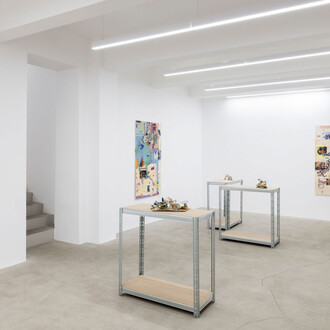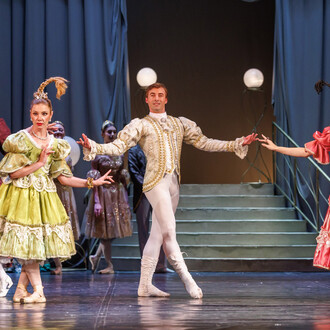The first moment he stepped foot in the building in Piazza Caiazzo in Milan he was dazzled by the space around which the stairs wound, by the harmony of its volumes and the right proportion of metal to marble, characteristics that together compose an almost “austere” Art Nouveau style, one without added frills. He felt struck by lightning, and before he even entered the lift that would take him to the apartment for rent on the fifth floor he turned to the real estate agent and said “I’ll take it.”
Seven years later, that staircase, like many others, was to become the subject of a photography book that reveals the beauty and fascination of this architectural element that unites heaven and earth. And, since 2010, the apartment has been the office of 5 Continents Editions, a publishing house dedicated to beauty, of which he, Eric Ghysels, is the high and only priest, on a mission—rather than profession—that goes against the tide. “I’m lucky: my passion is my work. Then again, you have to be crazy to be a publisher, and I am—totally. Let’s say someone approaches me about making a book on the countless shapes of pasta. I might accept the offer! All it takes is that element of surprise that sparks my enthusiasm and I will give my all to it.”
Sure enough, while 5 Continents is the world’s number one publisher of non-European art, and its catalogue ranges from the Middle Ages to the present day and is a reference for such museums as the MoMA in New York and the Louvre and Musée d’Orsay in Paris, it has also published books that are less to do with the arts than with the art of nature and with what humans have created with it. Like the “magical” staircases photographed by Luciano Romano and commented upon by Michel Serres in Le Regard Oblique, or the fantastic series of plant seeds, flowers, and vegetables, all those things from which life arises, explored by the lens of Paul Starosta in Graines and reproduced and enlarged on a black background. Stunning!
And the most recent, Artico, devoted to six years of winter expeditions to places ranging from Scandinavia to the remotest islands in Canada, narrated through the photographs and travel diaries of Vincent Munier. The book lays bare a world that lies hidden in the dazzling whiteness of the snow and introduces its inhabitants: bears, arctic foxes, wolves, owls, and musk oxen. “Nature is the most beautiful form of art and my primary source of inspiration. Now I am making a book on eggs. Yes, eggs! They are so perfect, they move me. You’ll see.”
And perfect, too, are the books published by 5 Continents. Everything—text, titles, illustrations—must have the right amount of space for them to relate harmoniously to one another. Eric is like a chef who measures out the ingredients; he does it to the millimetre and follows the creation of his books on a daily basis, page by page. Heaven forbid if there are any mistakes! Even one, however small, and “for me the book is dead.” This harmony of proportions and spacing was inherited from his father Jean-Pierre, a sculptor, and is now an essential part of his own existence.
As we talk in his study-cum-office on the fifth floor above the rooftops of a sun-splashed Milan, he shows me an example of this perfection. It is called Rivage and is a patinated bronze sculpture made by his father in 1984, in which bulges and angles blend in an almost musical aesthetic rhythm. Rivage stands alone on a base but other objects in the room are eloquent of the life of Eric Ghysels and his special family. A shield from northern Sudan hangs on the wall and vestiges of other worlds appear on the long, glass reunion table: a leather Tuareg necklace, a nineteenth-century Japanese wooden fork, and strange “forms” for making socks in Japan. All are souvenirs of journeys to distant lands, the confirmation of an unquenchable curiosity that has prompted a collection of objects from a wide variety of civilisations and cultures.
Everything began with a prize Jean-Pierre won in Paris for his sculptures. With the money he received, he bought a 2CV and drove off to India, as far as the temples of Khajuraho, where he was joined by Colette, Eric’s future mother, an impassioned ethnographer. They became the first Westerners to visit Nepal, where they got married on December 27, 1959 in Kathmandu. But this was just the start of a long series of trips to all corners of the globe, with their children in tow. Eric has never ceased to explore the world: whether by car, train, or plane he is constantly searching for things to marvel at, the same marvel out of which his books arise. “As a matter of fact, I’m a humanist more than a publisher, in the sense that I deeply love being human and everything that results from it, like music, architecture, art, and culture in general. I love finding things that are well made and it gives me pleasure to pass that knowledge on. I love beauty and think that it is a form of heritage, perhaps the only one that will save the world.”
These are words that may seem incomprehensible in the era of disposable goods, and it is in response to the idea of “single-use” articles that Ghysels has begun TailorMade, a publishing brand whose top quality publications are made to last. The first issue was dedicated to The Dancers from the Villa of the Papyri, five extraordinary bronze statues discovered beneath the volcanic ashes of the Vesuvius in Herculaneum. Housed in an elegant box, the photographs of Luigi Spina and account provided by archaeologist Stefano De Caro of these fascinating young women guide readers as they discover the origins of beauty. Printed in a limited edition of just 300 copies and containing 192 pages, the price of each volume is 950 euro. It is a project founded on the premise that less is more. “I don’t have a penny and I don’t want financing. Banks continually offer me money, but I don’t want to accept it. If I did, I would lose my freedom. What is the goal of a financier? To make a profit, of course. For me, however, my greatest gains begin with loss. I certainly incurred losses at the start with African art but I have become one of the leading publishers in that field and profits have naturally followed. I run this company like a father of a family and my financiers are human beings: artists, authors, museum directors, and contributors.”
Eric Ghysels is fifty-five and 5 Continents Editions is almost sixteen. He founded the company in 2002 after having worked at Franco Maria Ricci and then Skira. He was born in Belgium and lived there until he moved to Milan to be with Roberta, but 25% of his blood is Armenian, inherited from his mother. In spite of his many travels, however, Eric has never been to Armenia, even if he feels more Eastern than Western, both in his appearance and personality. “I am hot-blooded and very sensitive, which means I worry and get irritable,” he says. Since he was a small child he has been afraid of the dark and of eagles, but what terrorises him is death. “It’s like a train,” he explains. “It starts off slowly but then begins to speed up exponentially.”
He is fond of challenges. They bring out the best in him. He doesn’t complain about the difficulties of life because he feels they have helped him to mature. On the other hand, he dislikes compromises and tries to avoid them, even if sometimes they have to be accepted. “As long as they do not compromise on ethics. That I will not accept: either people are honest or dishonest, and with the latter I have no dealings.” The team who works with him are all Italian. He chose them not just for their skills but also for their ethics. “No CV: just a shake of the hand, a look in the eye, and an upright back. That’s how I do things.”
He feels like an orchestra conductor while the staff plays different instruments. It takes more than twenty people to make a book and he, the maestro among his artists, has to direct their efforts. But being a publisher is a little like being a father since a book is indeed a living thing, and after having been created, the child-book has to be cared for and helped to grow. Eric has two children, Giorgia and Matteo, but each year he publishes some thirty books—in Italian, French, and English, but also Russian and Chinese, or Japanese or German. There are also less expensive series that get distributed around the world, aimed at educating the young about their artistic heritage and astonishing them, in the same way as he, too, is astonished. Deep down, there is something of the child in Eric Ghysels. He knows it because he has the same kind of dreams. He dreams of holding an exhibition at the Grand Palais in Paris with children’s drawings and of being able to say that they are the works of the youthful imaginations of artists like Picasso and Cézanne. And he also dreams of assembling every journalists and telling them: “Ladies and gentlemen, I am an imposter. Those drawings were made by children from around the world, not by great artists.” In the meantime, he is planning a unique series dedicated to children: not books written by adults for kids, but by kids for adults. Take note, in Piazza Caiazzo in Milan, the “sixth continent” is about to appear.
















